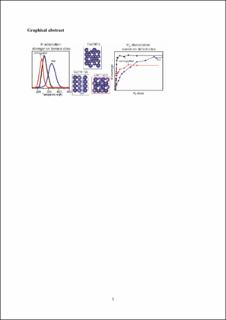| dc.contributor.author | Weststrate, Kees-Jan | |
| dc.contributor.author | Mahmoodinia, Mehdi | |
| dc.contributor.author | Farstad, Mari Helene | |
| dc.contributor.author | Svenum, Ingeborg-Helene | |
| dc.contributor.author | Strømsheim, Marie Døvre | |
| dc.contributor.author | Niemantsverdriet, Hans | |
| dc.contributor.author | Venvik, Hilde Johnsen | |
| dc.date.accessioned | 2020-11-25T08:50:39Z | |
| dc.date.available | 2020-11-25T08:50:39Z | |
| dc.date.created | 2019-06-18T11:32:21Z | |
| dc.date.issued | 2019 | |
| dc.identifier.issn | 0920-5861 | |
| dc.identifier.uri | https://hdl.handle.net/11250/2689473 | |
| dc.description.abstract | Cobalt catalysts are used on a commercial scale to produce synthetic fuels via the Fischer-Tropsch synthesis process. As adsorbed hydrogen atoms are involved in many of the elementary reaction steps that occur on the catalyst surface during the reaction it is of interest to study how the structure of the catalyst surface affects the reactivity with di-hydrogen as well as with adsorbed hydrogen atoms. In the present study we use a combination of experimental and theoretical methods to gain insight into how the structure of a cobalt surface affects the H2 dissociation reaction and the adsorption bond strength of the hydrogen atoms produced in this step. A comparison of the open Co(11–20) and (10–12) surfaces with the flat, close packed Co(0001) surface confirms that undercoordinated Co atoms strongly enhance the rate of H2 dissociation. At the same time, the lower desorption temperatures found on the more open surfaces indicate that the bond strength of adsorbed hydrogen decreases, in the following order: Co(0001)>Co(10–12)>Co(11–20). DFT calculations confirm this trend, showing that hydrogen adsorbs weaker on the more open surfaces for both low and high coverages. In the context of the Fischer-Tropsch synthesis reaction we propose that step and kink sites are important for efficient H2 dissociation. After dissociation, the higher hydrogen adsorption strength on terrace sites would promote diffusion away from the dissociation site to flat terraces where they can participate in hydrogenation reactions. | en_US |
| dc.language.iso | eng | en_US |
| dc.publisher | Elsevier | en_US |
| dc.rights | Attribution-NonCommercial-NoDerivatives 4.0 Internasjonal | * |
| dc.rights.uri | http://creativecommons.org/licenses/by-nc-nd/4.0/deed.no | * |
| dc.subject | structure sensitivity | en_US |
| dc.subject | Fischer-Tropsch synthesis | en_US |
| dc.subject | cobalt | en_US |
| dc.subject | Hydrogen adsorption | en_US |
| dc.title | Interaction of hydrogen with flat (0001) and corrugated (11–20) and (10–12) cobalt surfaces: Insights from experiment and theory | en_US |
| dc.type | Peer reviewed | en_US |
| dc.type | Journal article | en_US |
| dc.description.version | acceptedVersion | en_US |
| dc.rights.holder | © 2019 This is the authors’ accepted and refereed manuscript to the article. This manuscript version is made available under the CC-BY-NC-ND 4.0 license http://creativecommons.org/licenses/by-nc-nd/4.0/ | en_US |
| dc.source.pagenumber | 124-130 | en_US |
| dc.source.volume | 342 | en_US |
| dc.source.journal | Catalysis Today | en_US |
| dc.identifier.doi | 10.1016/j.cattod.2019.04.002 | |
| dc.identifier.cristin | 1705624 | |
| dc.relation.project | Norges forskningsråd: 280903 | en_US |
| dc.relation.project | Norges forskningsråd: 237922 | en_US |
| dc.relation.project | Notur/NorStore: nn9152k | en_US |
| dc.relation.project | Notur/NorStore: NN9152K | en_US |
| dc.source.articlenumber | 124-130 | en_US |
| cristin.unitcode | 7401,80,64,0 | |
| cristin.unitname | Materialer og nanoteknologi | |
| cristin.ispublished | true | |
| cristin.fulltext | postprint | |
| cristin.qualitycode | 2 | |

